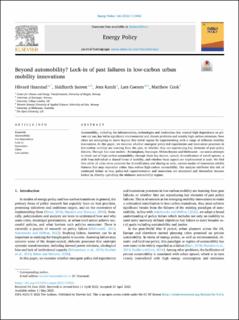| dc.contributor.author | Haarstad, Håvard | |
| dc.contributor.author | Sareen, Siddharth | |
| dc.contributor.author | Kandt, Jens | |
| dc.contributor.author | Coenen, Lars Martel Antoine | |
| dc.contributor.author | Cook, Matthew | |
| dc.date.accessioned | 2022-10-25T13:37:05Z | |
| dc.date.available | 2022-10-25T13:37:05Z | |
| dc.date.created | 2022-10-19T12:34:18Z | |
| dc.date.issued | 2022 | |
| dc.identifier.issn | 0301-4215 | |
| dc.identifier.uri | https://hdl.handle.net/11250/3028229 | |
| dc.description.abstract | Automobility, including the infrastructures, technologies and institutions that created high dependence on private car use, has led to significant environmental and climate problems and notably high carbon emissions. Now cities are attempting to move beyond this failed regime by experimenting with a range of different mobility innovations. In this paper, we examine whether emergent policy-led experiments and innovation processes in low-carbon mobility are learning from the past, or whether they are reproducing key elements of past policy failures. Through four case studies – Birmingham, Stavanger, Milton Keynes and Melbourne – we assess attempts to break out of high-carbon automobility through three key factors, namely diversification of travel options, a shift from individual to shared forms of mobility, and whether these aspects are implemented at scale. We find that while all cities show potential for diversification and sharing at scale, current modes of innovation exhibit features that may reproduce rather than reduce high-carbon automobility. Our analysis attributes this risk of continued failure to how policy-led experimentation and innovation are structured and themselves become locked in, thereby upholding the obdurate automobility regime. | en_US |
| dc.language.iso | eng | en_US |
| dc.publisher | Elsevier | en_US |
| dc.rights | Navngivelse 4.0 Internasjonal | * |
| dc.rights.uri | http://creativecommons.org/licenses/by/4.0/deed.no | * |
| dc.title | Beyond automobility? Lock-in of past failures in low-carbon urban mobility innovations | en_US |
| dc.type | Journal article | en_US |
| dc.type | Peer reviewed | en_US |
| dc.description.version | publishedVersion | en_US |
| dc.rights.holder | Copyright 2022 the authors | en_US |
| dc.source.articlenumber | 113002 | en_US |
| cristin.ispublished | true | |
| cristin.fulltext | original | |
| cristin.qualitycode | 1 | |
| dc.identifier.doi | 10.1016/j.enpol.2022.113002 | |
| dc.identifier.cristin | 2062763 | |
| dc.source.journal | Energy Policy | en_US |
| dc.relation.project | Norges forskningsråd: 321421 | |
| dc.identifier.citation | Energy Policy. 2022, 166, 113002. | en_US |
| dc.source.volume | 166 | en_US |

